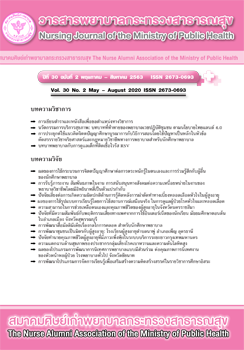Innovative Proactive Health Services: The Role of Community Nurse Practitioners in Response to Thailand 4.0
Main Article Content
Abstract
Innovative proactive health services are developed from the creative thinking of community nurse practitioners. It is a key factor in the 21st century’s competitive edge and the success of the nursing organization. For nursing organizations, leaders should promote their own creativity and that of the nursing team, along with the promotion and development of other capabilities to improve and develop nursing services efficiently and effectively in accordance with the requirements of the Thailand 4.0 policy, which will reflect the quality of services provided to clients. To accomplish this goal, one of the critical roles of Community Nursing Practitioner that impact the development of health service innovation is to activate critical and creative thinking to become part of the mindset of nurses. In order to understand the more complex practice situations of nurses, nurse practitioners should apply innovative proactive health services and jointly develop innovation to be and integral component of a sustainable nursing organization.
Article Details
บทความและรายงานวิจัยในวารสารพยาบาลกระทรวงสาธารณสุข เป็นความคิดเห็นของ ผู้เขียน มิใช่ของคณะผู้จัดทำ และมิใช่ความรับผิดชอบของสมาคมศิษย์เก่าพยาบาลกระทรวงสาธารณสุข ซึ่งสามารถนำไปอ้างอิงได้
References
2. Office of Policy and Strategy Ministry of Public Health. Summary of Thailand 4.0 in public health. Nonthaburi: Ministry of Public Health. 2017. (in Thai).
3. Thai Nursing Council. Announcement of the nursing council on specialty and competencies of advanced nursing practice in various categories. Government Gazette: Book 126, Special 16ง. 2009. (in Thai).
4. Thai Nursing Council. Announcement of the nursing council nursing standards 2019. the government gazette: Volume 136, Special 97ง. 2019. (in Thai).
5. Ruamtham T, Leethongdee S, Manwong M. Development model for research and innovation capacity building in routine-work, Warinchamrab Hospital, Ubon Ratchathani Province. UBRU Journal for Public Health Research 2019;8(2):186-195. (in Thai).
6. Srisuphan V, Senarat V, Nanthabutra K. Innovation in health promotion under the context of the nursing profession. 2nd ed. Nonthaburi: Nursing Council; 2016. (in Thai).
7. Khinsin C. Creative thinking to nursing service innovation. Journal of The Royal Thai Army Nurse 2014; 15(3):69-78. (in Thai).
8. Howkins J. “What are Creative Economies? And Why?” In Creative Thailand. Bangkok: Thailand Creative & Design Center (TCDC). 2008. (in Thai).
9. Kittisaknawin C. The relationship between creative thinking of emotional quotient (EQ) and mental retardation (SQ). Hat Yai Academic Journal 2011;9(1):75-82. (in Thai).
10. Office of the Royal Society. Royal Academy Dictionary[internet]. 2011 [cited 2020 Jan 25]. Available from:http://www.royin.go.th/?page_id=130
11. Klangtamnium K. Nursing service innovation. Journal of Phrapokklao Nursing College Chanthaburi 2011;22(2):71-79. (in Thai).
12. Nontasuta A. Innovation management in health systems. Journal of Public Health Research Khonkaen University 008;1(2):49-60. (in Thai).
13. Buacharoen H. Nursing roles in developing innovation for holistic metabolic syndrome management. Journal of Phrapokklao Nursing College Chanthaburi 2011;23(1):71-80. (in Thai).
14. Health System Research Institute and the Ministry of Public Health. Government action plan 4 years 2008-2011[internet]. 2011. [cited 2018 June 13]. Available from: http://www.bps.ops.moph.go.th/plan4year2/Plan4year 51-55/page225-233.pdf
15. Amabile TM. Componential theory of creativity[internet]. 2013. [cited 2018 June 13]. Available from: http://www.hbs.edu/faculty/Publication% 20Files/12-096.pdf
16. Fongkerd S. The self – health care experiences of caregiver’s older adults with bedridden patients. Journal of Boromarajonani College of Nursing, Surin 2019;9(1):69-89. (in Thai).
17. Siripanyawat S, Phayungkit S, Thiranan S, Nanthaporn S, Phan S,Distillkarn A. Nursing innovation in health promotion: system development in care for pressure ulcers. Journal of Nursing 2015;42 (Supplement): 171-177. (in Thai).
18. Phatthakanatakun P. The effect of using innovative latex mattresses to prevent pressure ulcers in patients with pressure ulcers. Nursing Journal of The Ministry of Public Health 2012; 22(1):48-60. (in Thai).
19. Melnyk BM, Fineout-Overholt E. Evidence-based practice in nursing & healthcare. Philadelphia: PA Lippincott Williams & Wilkins; 2005.
20. Thongsai S. Nursing and creative development. Journal of Phrapokklao Nursing College Chanthaburi 2016; 27(1):112-9. (in Thai).

